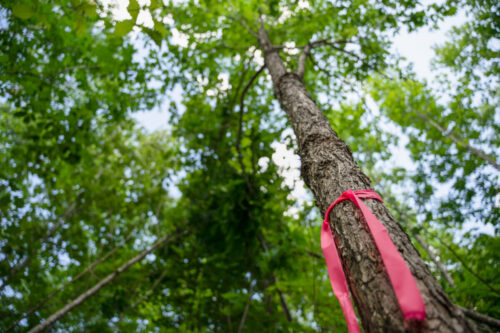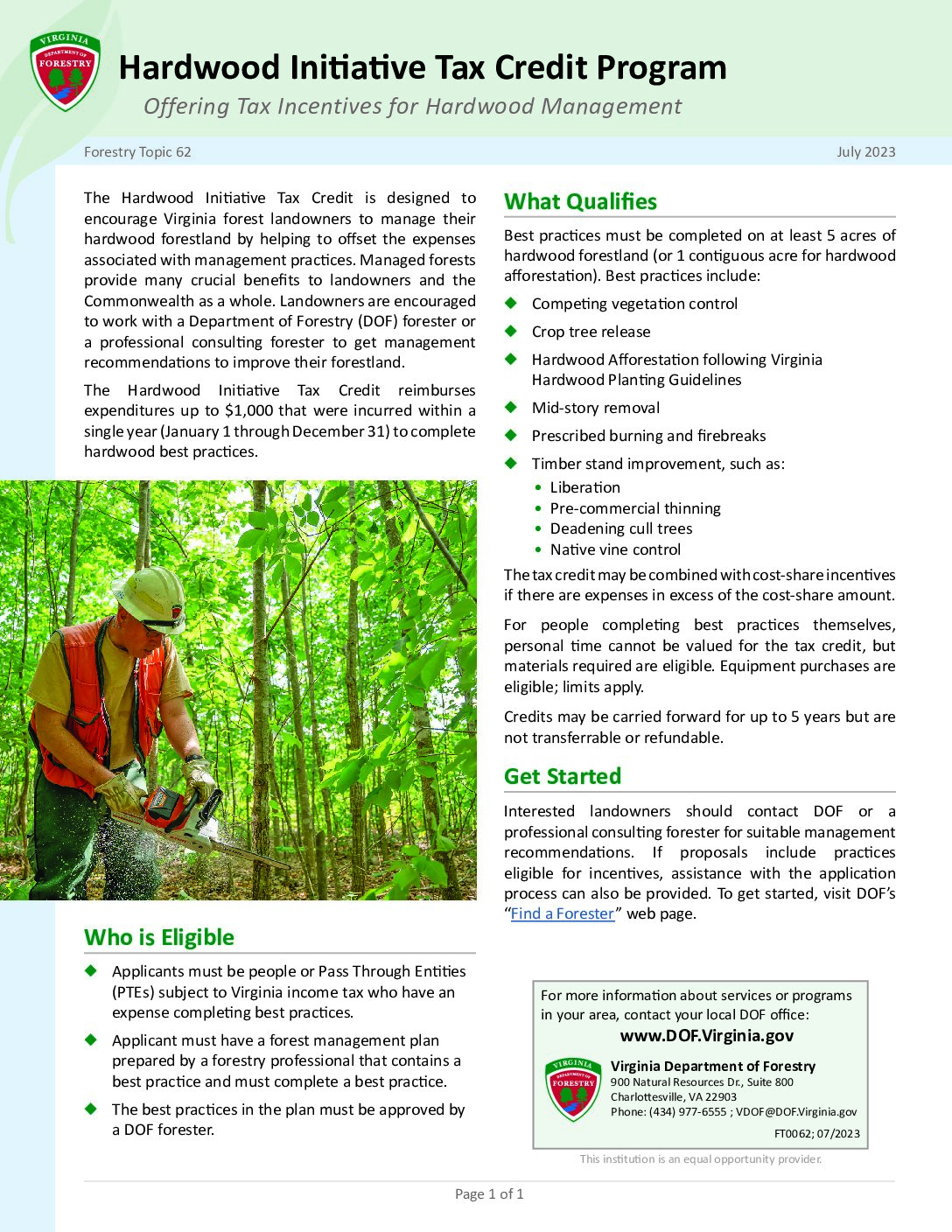 Virginia’s hardwood initiative promotes quality hardwood management to grow healthy hardwood forests today and tomorrow. With more than 80% of Virginia’s forestland being privately owned, Virginia Department of Forestry (DOF) needs cooperation from landowners to reverse the decline in our hardwood forests through the implementation of best practices. In addition to improving our forests, activities that facilitate tree regeneration are often beneficial to game and other wildlife.
Virginia’s hardwood initiative promotes quality hardwood management to grow healthy hardwood forests today and tomorrow. With more than 80% of Virginia’s forestland being privately owned, Virginia Department of Forestry (DOF) needs cooperation from landowners to reverse the decline in our hardwood forests through the implementation of best practices. In addition to improving our forests, activities that facilitate tree regeneration are often beneficial to game and other wildlife.
The hardwood initiative is funded by Virginia state budget bill HB1800.
Forest management starts with setting goals. As part of the hardwood initiative, DOF foresters and consultants work closely with landowners to discuss ownership objectives. Once determined, the forester will perform assessments and offer recommendations in the form of a management plan. The plan will outline suitable practices based on the data and desired outcomes.
Recommendations may include management practices eligible for incentives. Foresters can help eligible landowners apply for incentives to put plans into action.
Hardwood management practices take many different forms. Some involve a harvest and timber sale that produce income; others do not produce income in the short term, but instead enable a forest to be productive and valuable in the future. These often require either time and effort, or an expense from the landowner.
To offset these challenges and promote hardwood management, DOF will soon offer incentives to reduce the cost of some hardwood management practices.
Learn more about hardwood management practices.
This program provides cost-share funds to landowners who complete eligible hardwood management practices.
Learn more about the Hardwood Initiative Cost-Share Program.
This tax credit matches out-of-pocket cost of eligible hardwood management work up to $1,000.
Learn more about the Hardwood Initiative Tax Credit Program.
Get started managing your hardwood forest.
Watch: Hardwood Forest Management
This video talks about the challenges Virginia’s hardwood forests face and how the DOF, consulting foresters and landowners are working together to cultivate the forests of tomorrow.
Virginia’s blessed to have rich forest resources. Over 60% of Virginia is forested and of that, 80% of it is what we call hardwood, deciduous trees like oaks, poplars, maples and those types of trees. What we’re finding is that there’s a lack of regeneration or that’s the young trees coming up, the next generation of forest, particularly the oaks.
My family and I own about 500 acres of forested land in Nelson County, Virginia. Land that’s been in our family for a number of generations. And so, we have three generations of our family now, my kids and my grandkids. So, we think generationally about the property.
My consulting forester, Bob Warring was cruising the timber and he saw that there was a lot of white oak coming up by itself and he suggested that perhaps we wanted to switch over from loblolly pine to white oak intentionally. We had, as expected, a lot of natural loblolly pine regeneration, but also white oak resprouting from the stumps in the understory.
It was decided to do a prescribed burn, which Bill Perry, the area forester, did along with a lot of other people from the department of forestry. It was successful in that it killed most of the natural loblolly. We could either have gone with an herbicide or with prescribed burn. I spend part of my time in California. I was extremely nervous. But during the whole process, I felt supported by the Department of Forestry and my forester and it worked out extremely well.
I do think that any landowner, any forester who’s looking at a stand of timber that they’re considering cutting, plan in advance and think about what you want to regenerate, what you want to grow there next. Maybe you need to take some other steps first, like herbicide or some kind of a partial cut like a shelterwood cut. And there’s good cost share on all these hardwood practices which basically pay 75% of the landowner’s expense. And then it’s also possible to get a tax credit.
So the hardwood initiative, there’s several practices from stand marking to prescribed burning to understory competition control, both native and invasive. Several of these such as the marking and the prescribed burning that was done on this property can be done by the department of forestry, but there’s several private contractors out there for all of these practices and local consultants and the DOF keeps up-to-date lists for these contractors. So, you know, if there’s a consultant that you work with or would like to work with, it’d be worth getting in contact with them to see if they have gone through the appropriate trainings and if this program would be available through them.
Of the forests in Virginia, about 80% are privately owned by private individuals and small companies and those are the folks who make the individual decisions. The department of forestry as well as other professional foresters and consulting foresters work with landowners to help them identify their objectives, prepare forest management plans and be attuned to their objectives for management.
Additional Resources
| Image | Title | ID | Description | Date | Content Type | View | hf:tax:document-category | hf:tax:Media |
|---|---|---|---|---|---|---|---|---|
 | Hardwood Management Practices – Improving Hardwood Forests with Proper Forest Management | FT0070 | Information sheet details hardwood management practices for establishment, regeneration, and tending stages to improve hardwood forests. Printed copies available. | 06/10/2025 | Publication | View | forest-management | publication |
| Hardwood Assessment Tool (HAT) | This Hardwood Assessment Tool (HAT) aids in gathering and summarizing data for management plans. | 05/31/2025 | Resource, Template | View | forest-management | resource template | ||
 | Hardwood Initiative Tax Credit Program – Offering Tax Incentives for Hardwood Management | FT0062 | Information sheet details the Department of Forestry’s Hardwood Initiative Tax Credit Program, including eligibility and qualifications. Printed copies available. | 05/20/2025 | Publication | View | financial-assistance-forest-management forest-management | publication |
| Hardwood Initiative Tax Credit Application | 7.29 | Application to apply for Hardwood Initiative Tax Credit. | 05/07/2025 | Form | View | financial-assistance-forest-management forest-management | form | |
 | Hardwood Initiative Cost-Share Program – Cost Assistance for Hardwood Management | FT0071 | Forestry topic information sheet provides information about Department of Forestry’s Hardwood Initiative Cost-Share Program, who is eligible and what qualifies for cost share. | 04/29/2025 | Publication | View | financial-assistance-forest-management forest-management | publication |
 | Hardwood Initiative – Improving Hardwood Forests for Future Generations | FT0061 | Forestry topic information sheet provides information about Department of Forestry’s hardwood initiative to bring focus to improving hardwood forests for future generations. | 06/01/2023 | Publication | View | forest-management | publication |
Contact Us
DOF foresters can assist you with your forestland, contact your local DOF forester.
For more information or questions, e-mail us or use our contact form.
